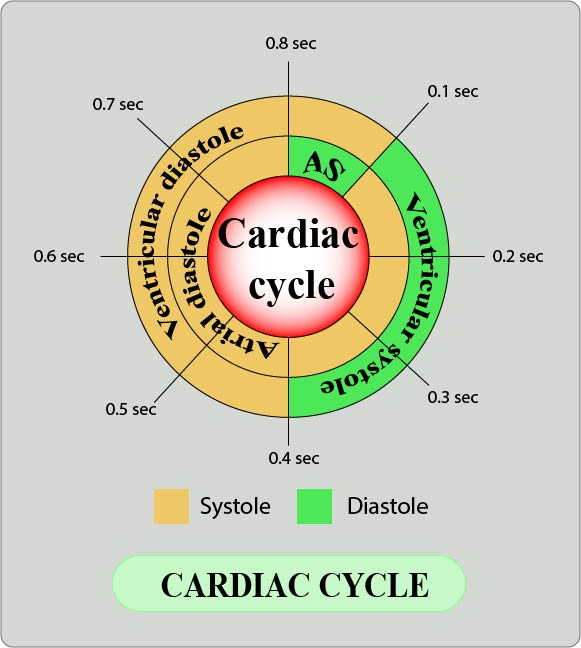
The duration of cardiac cycle is
(a) 0.8 sec
(b) 0.8 sec
(c) 0.08 sec
(d) 0.008 sec
Answer
579.6k+ views
Hint: Sequence of alternating contraction and relaxation of the atria and ventricles in order to pump blood throughout the body is called a cardiac cycle. It starts at the beginning of one heartbeat and ends at the beginning of another.
Complete answer:
diastole, is the reciprocal of the heart rate. It consists of a period of relaxation called diastole, during which the heart fills with blood, followed by a period of contraction called systole. For e.g. If heart rate is 72 beats/min, the duration of the cardiac cycle is 1/72 beats/min about 0.0139 minutes per beat, or 0.833 seconds per beat.
Additional information:
SA node or the pacemaker has the property of automaticity and rhythmicity. Due to this it produces action potentials, which spread all along the atrial and ventricular muscle fibers. This ultimately brings about depolarization and repolarization. These various changes occur in the heart, which is repeated from beat to beat. These events are known as events of cardiac cycle.
So, the correct answer is 0.8 sec.

Note:
- Each cardiac cycle has a diastolic phase where the heart chamber is in state of relaxation and fills with blood that receives from the veins and a systolic phase where the heart chambers contracts and pumps the blood towards the periphery via the arteries.
- Both the atria and the ventricles undergo alternating states of systole and diastole.i.e.when the atria are in diastole, the ventricles are in systole and vice versa.
Complete answer:
diastole, is the reciprocal of the heart rate. It consists of a period of relaxation called diastole, during which the heart fills with blood, followed by a period of contraction called systole. For e.g. If heart rate is 72 beats/min, the duration of the cardiac cycle is 1/72 beats/min about 0.0139 minutes per beat, or 0.833 seconds per beat.
Additional information:
SA node or the pacemaker has the property of automaticity and rhythmicity. Due to this it produces action potentials, which spread all along the atrial and ventricular muscle fibers. This ultimately brings about depolarization and repolarization. These various changes occur in the heart, which is repeated from beat to beat. These events are known as events of cardiac cycle.
So, the correct answer is 0.8 sec.

Note:
- Each cardiac cycle has a diastolic phase where the heart chamber is in state of relaxation and fills with blood that receives from the veins and a systolic phase where the heart chambers contracts and pumps the blood towards the periphery via the arteries.
- Both the atria and the ventricles undergo alternating states of systole and diastole.i.e.when the atria are in diastole, the ventricles are in systole and vice versa.
Recently Updated Pages
Why are manures considered better than fertilizers class 11 biology CBSE

Find the coordinates of the midpoint of the line segment class 11 maths CBSE

Distinguish between static friction limiting friction class 11 physics CBSE

The Chairman of the constituent Assembly was A Jawaharlal class 11 social science CBSE

The first National Commission on Labour NCL submitted class 11 social science CBSE

Number of all subshell of n + l 7 is A 4 B 5 C 6 D class 11 chemistry CBSE

Trending doubts
10 examples of friction in our daily life

One Metric ton is equal to kg A 10000 B 1000 C 100 class 11 physics CBSE

Difference Between Prokaryotic Cells and Eukaryotic Cells

1 Quintal is equal to a 110 kg b 10 kg c 100kg d 1000 class 11 physics CBSE

State the laws of reflection of light

Explain zero factorial class 11 maths CBSE




